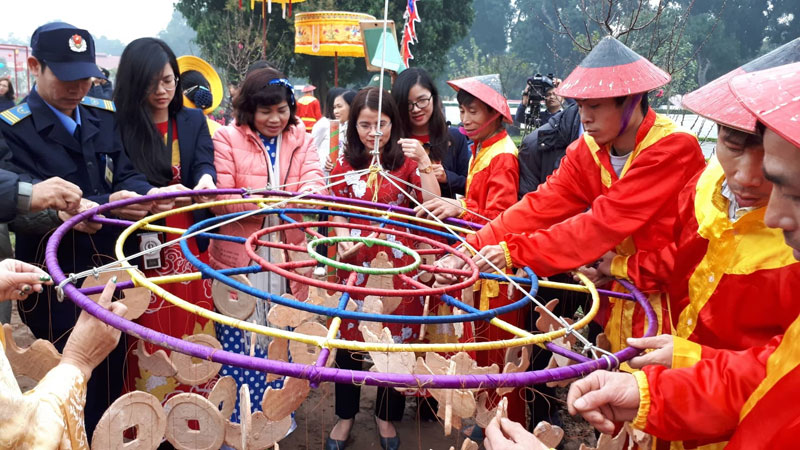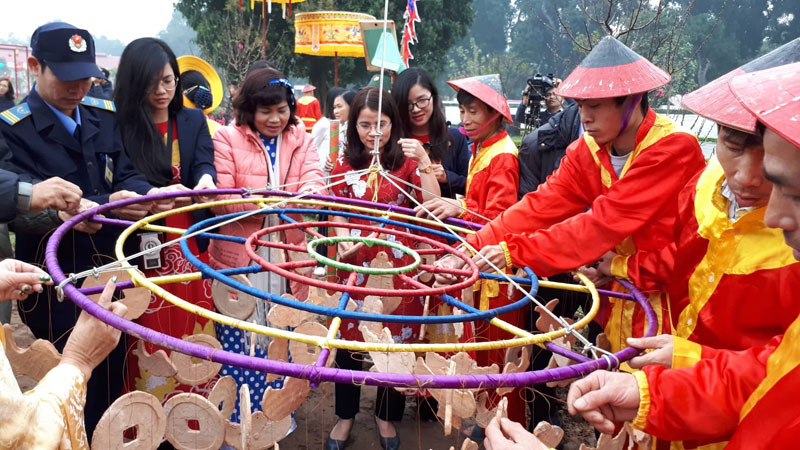
Traditional rituals to see off the old year and ring in the new year were performed at the Imperial Citadel of Thang Long, a UNESCO world heritage site, on January 26.

Decorating the Tet bamboo pole (Photo: Hoang Thanh Thang Long).
The activity kicked off a series of events to be held within the premises of the heritage site in order to welcome the year of the pig.
The event was attended by leaders of the Vietnamese Fatherland, the Ministry of Foreign Affairs, the Hanoi government, overseas Vietnamese and residents of the capital city.
The reproduced rituals included an offering to the Kitchen Gods, the release of carp into an ancient river at the archaeological site of 18 Hoang Dieu and the erection of a bamboo pole in front of the Doan Mon Gate.

A Tet bamboo pole is be put up at the imperial citdatel (Photo: Hoang Thanh Thang Long)
A delegation of overseas Vietnamese who will attend the Homeland Spring programme later in the day also offered incense at the imperial citadel.
To welcome the new year, an exhibition was held at 19C Hoang Dieu featuring cultural traditions that remind people of Tet in bygone days, while kids could experience folk games and enjoy exciting water puppetry performances.
According to the organisers, the re-enactment of the traditional rituals will help safeguard the traditional culture within the heritage site.
The Imperial Citadel of Thang Long will close during February 3-5 and reopen on February 6, or the second day of the Lunar New Year.
Source: NDO
With an increasingly vibrant and widespread emulation movement aimed at building cultured residential areas and cultured families, Yen Thuy District has been making steady progress toward improving both the material and spiritual well-being of its people, while fostering a civilized, prosperous, beautiful, and progressive community.
Once lacking recreational spaces and community facilities, Residential Group 2 in Quynh Lam Ward (Hoa Binh City) has recently received attention for the construction of a new, spacious, and fully equipped cultural house. The project followed the model of state support combined with public contributions in both labor and funding.
The "All people unite to build cultural life" movement, which has been effectively integrated with Kim Boi district’s socio-economic development goals, is fostering a lively spirit of emulation across local residential areas, hamlets, villages, public agencies, and enterprises. In addition, through the initiative, traditional cultural values are being preserved and promoted, while community solidarity and mutual support in poverty reduction and economic development are being strengthened.
A working delegation of the Hoa Binh provincial People’s Committee led by its Permanent Vice Chairman Nguyen Van Toan on June 11 inspected the progress of a project to build the Mo Muong Cultural Heritage Conservation Space linked to tourism services in Hop Phong commune, Cao Phong district.
Born and growing in the heroic land of Muong Dong, Dinh Thi Kieu Dung, a resident in Bo town of Kim Boi district, in her childhood was nurtured by the sweet lullabies of her grandmother and mother. These melodies deeply imprinted on her soul, becoming an inseparable part of her love for her ethnic group's culture. For over 20 years, this love for her hometown has driven Dung to research, collect, and pass down the cultural values of the Muong people to future generations.
In the final days of May, the Ethnic Art Troupe of Hoa Binh Province organized performances to serve the people in remote, mountainous, and particularly disadvantaged areas within the province. These were not just ordinary artistic shows, but they were the meaningful journeys aimed at spreading cultural values, enhancing the spiritual life of the people and contributing to the preservation of ethnic minority cultural identities.



